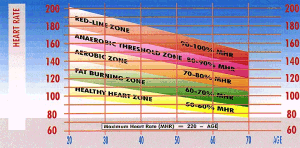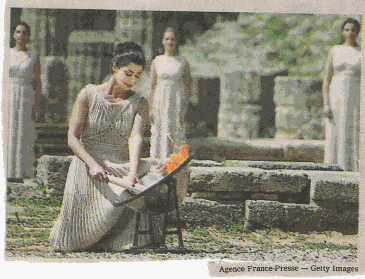Editorial
- Teaching
Healthy Lifestyle Decision-Making. |
|
When I think of how I wanted to share what I knew about
a body’s response to exercise and how problematic that turned
out to be, I still laugh. As I wrote in my last column, during my
career we physical educators had to rely on the kids to count for
themselves and record it accurately. In thirty-one years of teaching
I had both funny and shocking stories about kids doing their own
scoring (stories which happily found their way into Too Dangerous
to Teach) and was frustrated when I wanted results to be meaningful.
Then heart rate monitors appeared, but they were expensive and not
widely used. Thanks to my sister, a health enthusiast, who didn’t
care about cost, I became the proud recipient of my own. I used
it religiously at first, and then learned my body so well, that
I felt when I was out of my zone and knew whether to speed up or
slow down to get back to it. Once I could understand my own biofeedback,
I left the monitor in the drawer, unused until I realized that even
my one monitor could serve a good purpose in class.
I’d been having kids take their resting pulse, working pulse
and recovery pulse during the fitness unit for years, but suddenly
it didn’t seem that the feedback they were getting from the
effort was working as anticipated. So, one day I brought in my monitor,
offered it to whomever wanted to wear it, and asked the volunteer
to share what it read during different phases of our dance–aerobic
routine—warm-up, moderate–energy, high-energy, cool down
and stretching. I did the same with the kids during weight training.
That peeked some curiosity and during subsequent lessons, different
students volunteered to wear it. In the end, with even one monitor,
the accurate and immediate feedback provided a valuable lesson.
What made that most clear was when, later that year, several students,
who had seemed apathetic about fitness, came to my office asking
if they could borrow my monitor for a research project.
I don’t think that heart rate monitors are necessary to be
a good teacher or be able to provide a good lesson. I do, however,
suggest their use in the beginner, intermediate and advanced fitness
units in Complete Physical Education Plans for Grades 7–12.
Personally, with all that said, I would opt for a sports monitor
instead. Users can read time, measure heart rates, count steps,
distance and calories and have a built in count-down timer and stopwatch
in one device. With that kind of versatility, I simply cannot imagine
a physical educator without one. Not, when they provide immediate
feedback, display reliable results and are easy to wear. What is
more, given all that they do, they are reasonably priced.
Still, I must share that I do not believe that they are what some
of their advertising claims them to be—a multifunction item
that “can take good care of your health.” You see, I believe
that it is you and your students who have to take good care of your
health. A sports monitor can’t.
Isobel R. Kleinman
Secondary Section Editor

|
|
Physical education’s
goal is to help students find at least one activity they really
enjoy, help them develop (a) adequate skill to participate joyfully
at least at a recreational level, (b) an understanding of rules
and strategies, (c) the ability to participate safely, and (d)
an understanding of how to get started, how to continue to learn,
and how to stay involved and persist across their lives.
- Dr. Leslie Lambert
|

|
 |
|
Compliments of Cardiosport.com
Exercising at the right intensity is the key to meeting fitness
goals. Different heart rate zones do different things. Some more
effectively burn fat, others improve performance, and others improve
stamina. The basic variable is the maximum heart rate (MHR) one
trains at and the fitness goal being aimed for.
Determining Maximum Heart Rate
- A treadmill test with a cardiologist or qualified exercise physiologist
is preferred if over 35, overweight or with a family history of
heart disease.
- Sedentary individuals should use 220 minus one’s age to
determine MHR. If you exercise aerobically 3 or more times a week,
use 205 minus half your age.
Intensity of Exercise
- Beginners who was to improve overall fitness, lose weight, or
reduce stress, should exercise in the healthy heart zone which
is 50–59 % of their maximum heart rate (MHR).
- For regular exercisers who want to lose body fat, use the fat
burning zone – 60-69% MHR
- To improve aerobic capacity or athletic performance, use the
aerobic zone - 70–79% MHR.
- Competitive athletes who push into an anaerobic threshold—80–89%
MHR—train muscles to handle lactic acid. Exercising regularly
at a heart rate that is too high does not provide additional aerobic
benefit, but does increase their possibility of athletic injury.
Such training (interval training) requires a high degree of fitness
and is not necessary for general fitness.
Target Zone Chart

|
|
For biking gear see www.nashbar.com
(big sale on winter merchandise)
For dancewear call Dance Distributors –
1 800 333–2623 (great prices)
For physical education suppliers catch the sale, see
www.ssww.com
|

|
The Cool Spot is an interactive website designed for young people
that provides information about alcohol.
I can tell you in my brief visit to the site, it sure appears
to have either been designed and developed by young people or,
at the very least, test marketed with them. My bet is that middle
and high school students would respond positively to this site.
|

| If you have ideas, comments,
letters to share, or questions about particular topics, please
email one of the following Secondary Section Editors: |
|

|
 |
| Shopping for heart rate monitors? Here
are some websites you might look at |

|
Ken Reed, in Elitism in Youth Sports Yields Physical
Fatness (NY Times, February 1, 2004) laments that though our
youth face “scary” health implications from an “epidemic”
of obesity and lack of physical fitness, most school districts
find physical education “easy to chop.” He sites Colorado
and South Dakota as two states with no physical education mandate.
According to him, the failure to provide adequate physical education
is only one side of the coin. As we broaden our interscholastic
programs, our emphasis goes into sports programs that force too
many of our older youth to the sidelines to watch.
Kirk Johnson, writes that although Colorado had enjoyed a fit
image and lean image, their obesity rate surged 17 percent in
one year and has more than doubled over the decade. To combat
this problem, they have started programs like Colorado on the
Move to get people walking and have asked corporations to
give employees the opportunity to exercise during the day. In
addition, they are renovating the old Denver airport surrounds
with a park designed for an active life style. No mention, however,
was made of mandating Physical Education in their schools. (Colorado
Takes Strides to polish Thin and Fit Image, NY Times, February
1, 2004)
Golf enthusiasts can now have a putter that forgives its users
lack of skill. The Odyssey 2 Ball Putter helps its user visualize
a straight hit right on the ball. Read more about it and the history
of inventions in the pursuit of good golf scores in Consumed
by Rob Walker (The New York Times Magazine Section, March 14,
2004).
The Olympic Torch Relay began with actress Thalia Prokopiou lighting
the torch.

Death Rate From Obesity Gains Fast on Smoking, (NY Times,
March 10, 2004). “Poor diets and physical inactivity caused
400,000 deaths, which is 16.6 percent of the total. An estimated
64 percent of the population is overweight or obese says the Center
for Disease Control and Prevention.
Some Myths and Facts About Fitness Habits (American
Cancer Institute for Cancer Research Newsletter, Spring, 2004)
- Recommendations for activity do not decrease by age. They
don’t even vary. To protect against cancer and other ailments,
one should aim for an hour of total moderate activity a day
and one hour of vigorous activity a week.
- A brisk walk a day is not enough. Strength training and stretching
are necessities to stay fit.
- When suffering back pain and arthritis, rest is not best.
It may even worsen the problem. An appropriate program will
help those afflicted get stronger, more flexible and suffer
less.
- Sports drinks keep you hydrated but come with calories. It
is best to drink water. Eight glasses a day are recommended.
- Age is no indicator for loss of fitness. If you stay fit,
your body can perform better than someone younger.
- You do not have to exercise at 30 minute intervals to get
health benefits. Ten minutes will do, but you must do six 10
minute intervals throughout the day.
|
|




